
image by Ivan Sache, 4 January 2009

Last modified: 2009-08-08 by dov gutterman
Keywords: education |
Links: FOTW homepage |
search |
disclaimer and copyright |
write us |
mirrors
See Also:
Other Institutions:

image by Ivan Sache, 4 January 2009
"Instituto Madre del Bon Consejo" is an
"educative citadel" founded in 1972 by Mother Verónica
Tejedor in Floridablanca, Department of Santander. Since 2003,
the institute has been ruling four seats all located in
Floridablanca, "Instituto Madre del Bon Consejo" (main
seat), "Instituto Domigo Sabio", "Instituto Josefa
del Castillo" and "Instituto El Progreso".
The flag of the institute, as shown graphically and described on
the website
of the institute, is vertically divided King blue-white, with
the emblem of the institute in the upper left part of the white
field, and five blue SW-NE diagonal stripes in the lower fly of
the flag. Blue represents peace and harmony, and the diagonal
stripes represent the ladder to excellence.
The emblem of the institute is a shield with the name of the
institute written in the border, the red letters
"IMBC", a yellow book representing science, a football
ball representing sports and a torch representing the flame of
knowledge.
Ivan Sache, 4 January 2009

image by Ivan Sache, 2 February 2009
"Gimnasio 'Madre de Trinidad de Calcuta'" is located
at Alamos Norte, Bogotá.
The flag of the institute, as shown graphically on the website
of the institute, is horizontally divided green-white.
Ivan Sache, 2 February 2009

flag according to image
image by António Martins-Tuválkin, 6 January 2009

suspected flag with regular colors (see below)
image by António Martins-Tuválkin, 6 January 2009
"Universidad del Magdalena" was founded in Santa
Marta in 1962.
The flag of the
university, as shown graphically on the university
website, is horizontally divided, the upper stripe being
golden yellow and the lower stripe vertically divided into two
equal blue and red fields. The emblem of the university is placed
in the middle of the flag.
The emblem of the flag is a disk horizontally divided brown-blue
with a four-directions rose wind overall, whose northern point
ends in a vertically divided yellow-blue fleur-de-lis, and a
golden bird in the upper part.
Ivan Sache, 30 December 2008
I suspect that these colors are standing for regular flag
colors (taken from the national flag) in
the actual flag.
António Martins-Tuválkin, 6 January 2009
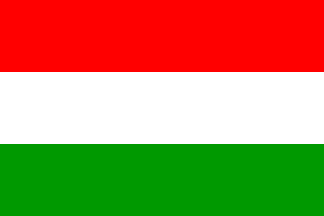
image by Ivan Sache, 1 February 2009
"Liceo 'Manuel José Caicedo'" was founded in 1949
by Priest Louis Eduardo Pérez Molina in Barbosa, Department of
Antioquia. The institute is named after Manuel José Caicedo
(1850-1937), first Archbishop of Popayán (1901-1905), and then
Archbishop of Medellín (Bishop in 1905, as Cayzedo), who had
ordained priest the founder of the institute.
The flag of the institute, as shown graphically and described on
the website
of the institute, is horizontally divided red-white-green.
Red stands for energy and vitality. White stands for purity and
chastity. Green stands for hope and aspiration to a better future
through study.
By pure coincidence, this flag is also used, but with proportions
1:2, by the non-related municipality of Barbosa,
Department of Santander.
Ivan Sache, 1 February 2009

image by Ivan Sache, 9 June 2001

image by Carlos Thompson, 24 June 2003
Universidad Manuela Beltran (Bogotá)
- 2:3 (by default) flag, horizontally divided white-red. Flag
shown on <www.umb.edu.co>,
located by Dov Gutterman.
Symbolics:
- White stands for peace, science and academic harmony.
- Red stands for effort and solitary work.
Ivan Sache, 9 June 2001
In the website of the university reported above they only say
that the colors of the flag are white and red and some drawing
that is not a flag is shown, suggesting a horizontal divided
flag. In <www.umb.edu.co>
, there is a picture of the flag and a link to an animated
version. This annimate version is horizontal white over
red, with the emblem. The photograph is from a stand flag
but it seems to be diagonal divided, white on the top-hoist and
red on the fly-bottom, and includes the emblem (set diagonally so
at it looks right in the stand flag).
The flag I have seen flying is diagonally divided, with no
emblem. Let me confiirm, I am pretty sure it is diagonally
divided but last time I checked there was no wind (and I was
driving) so I am not sure on the disposition of the colors.
Red seemed to be above, and white seemed to be towards the fly,
anyhow.
Carlos Thompson, 24 June 2003
"Colegio 'Marco Antonio Carreño Silva'" is located
in Bogotá.
The flag of the institute,
as shown graphically and described on the website
of the institute, is green with a white ascending diagonal
stripe and the emblem of the institute in the middle (represented
as a white disk on the drawing but explicitely mentioned in the
description). Green symbolizes hope and white the pacific common
life. The orientation of the stripe represents the constant
permanent and institutional improvement.
The emblem of the institute has a green border charged with the
three pillars of the institute, in white letters:
"AUTONOMÍA" (left), "PARTICIPACIÓN"
(right), and "CREATIVIDAD" (top), the flag of Bogotá
(horizontally divided yellow-red, without the coat of arms), and
the flag of the institute. The shield is blue, divided into three
parts by two green branches of laurel emerging from a single
stem, representing the fulfillment of the objectives proposed in
the institute. Above the branches are two open hands, symbolizing
unity and strength, on the left, a book, symbolizing science, on
the right a computer, representing access to knowledge through
technology, and under the stem the five Olympic rings,
symbolizing sociability, fraternity, equity, solidarity and
diversity.
Ivan Sache, 17 January 2009
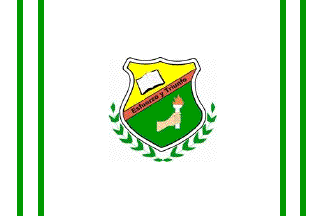
image by Ivan Sache, 1 February 2009
"Colegio 'Marco Fidel Suárez'" was created on 1
December 1967 (Decree No. 011) in Zulia, Departement of Norte del
Santander. The institute is named after Marco Fidel Suárez
(1855-1927), President of Colombia from 1918 to 1922, and also a
famous writer.
The flag of the institute, as shown graphically and described on
the website
of the institute, is white with two thin vertical green lines
near the host and another two near the fly, and the emblem of the
institute in the middle. White represents aspiration to peace
while green represents the ecological awareness of the community
of Zulia.
The emblem of the institute is diagonally divided yellow-red by a
red-orange ascending diagonal stripe charged with "Esfuerzo
y Triunfo" (Strength and Triumph) in black letters, a
reference to Marco Fidel Suárez' life . The yellow field is
charged with a white open book while the green part is charged
with a white torch hold by a hand.
Ivan Sache, 1 February 2009

image by Ivan Sache, 8 January 2004
"Colegio 'María Auxiliadora'" (COLMAUXI) was
founded in 1955, as "Colegio San Juan Bosco", by priest
José Darío Ovies Garcés in Guadalupe, Department of Huila.
Closed in 1959 because of the lack of official license, the
college was reopened on 8 March 1960 under its current name and
placed under the administration of the parish of Nuestra Señora
de Guadalupe. Official website at here.
The flag of COLMAUXI is shown on a photo
taken during the celebration of Independence Day as horizontally
divided light blue-pink (as it was shown graphically on a defunct
webpage located by Dov Gutterman on 8 January 2004) . However,
the graphic
representation of the flag on the institute's website shows
the flag with reverted colours.
Ivan Sache, 5 August 2009

image by Ivan Sache, 9 January 2004
The College is located in Pasto, Narino department. Its flag
is horizontally divided blue-white-red (2:1:1).
Source: <www.voluntad.com.co>,
located by Dov Gutterman.
Ivan Sache, 9 January 2004
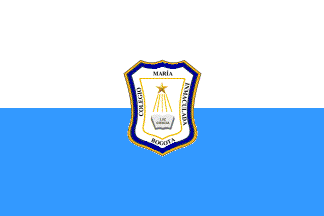
image by Ivan Sache, 11 January 2009
"Colegio María Inmaculada" was founded in 1906 in
Bogotá, as "Sagrada Familia" (Holy Family) by the
Community of the Tertiary Capuchin Sisters, a community founded
by Friar Luis Amigó on 4 April 1905 in Riohacha, Department of
Guajira.
The flag of the institute can be seen on the stage on photos
taken during the celebration of the Family Day 2007.
The flag, as shown graphically and described on the website of
the institute, is horizontally divided white-light blue with the
emblem of the institute in the middle.
The emblem of the institute shows a yellow star sending four
yellow rays to an open book charged with the words "LUZ /
CIENCIA" (Light / Science).
Ivan Sache, 11 January 2009

image by Ivan Sache, 18 January 2009
"Colegio Distrital Técnico Menorah" was set up by
Contract No. 771 signed on 14 December 1974 between the Secretary
of Education of Bogotá and the B'nai B'rith Jewish Ladies'
association. The Menorah Foundation, set up on 22 November 1993
in Bogotá and incorporated on 22 April 2003 in Miami, USA, is in
charge of the equipment and management of the institute.
The menorah, a seven-branched candelabrum, has been a symbol of
Judaism for almost 3000 years and is the emblem of Israel.
The flag of the institute, as shown graphically on the website
of the institute, is horizontally divided
white-blue-white-blue-white.
Overall and respective stripe proportions are not given, but it
can be assumed they fit the specifications of the national flag
of Israel.
Ivan Sache, 18 January 2009

image by Ivan Sache, 8 January 2009
"Liceo Feminino 'Mercedes Nariño'" was founded on 5
October 1916 in Bogotá by Priest Diego Garzón, as
"Sindicato de la Aguja, Artes y Oficios" (Syndicate of
Needle, Arts and Works) to prepare women to household work. The
institute was later renamed "Escuela Departamental Superior
de Artes y Oficios para señoritas" (Departmental Higher
School of Arts and Works for Women) and "Liceo Femenino de
Cundinamarca" (1958). On 18 June 1960 (Decree No. 778), the
institute was dedicated to Mercedes Nariño, the daughter of the
precursor of the national independence, Antonio Nariño.
The flag of the institute, as shown graphically and described on
the website
of the institute, is horizontally divided blue-white-red.
Blue represents loyalty, confidence, knowledge, intelligence,
faith, truth and eternal heavens.
White is associated to light, kindness, innocence and purity; it
is considered as the colour of perfection.
Red represents energy, vitality, power, force, passion, value,
aggressivness and courage.
Ivan Sache, 8 January 2009
"Corporación Universitaria del Meta" (aka Unimeta)
was founded on 16 November 1982 in Villavicencio. Redacted by
Rafael Mojica García, the statutes of the university were
approved on 28 March 1983. The university was recognized by the
Ministry of National Education on 5 August 1985 (Decree No.
12249, published in the Colombian official gazette on 16
September 1985).
The flag of the university is prescribed by Decree No. 009 of 31
August 1988, signed by Rector Rafael Mojica García.
"Article 1.
The flag of the "Corporación Universitaria del Meta"
shows on a reseda yellow ("gualda") background a
cardinal red ("purpurada") St. Andrew cross stretching
diagonally over the flag. On the cross are placed six blue stars
representing the areas of knowledge prescribed in the university
statutes.
Article 2.
The colours match the patriotic colours."
The Decree is given on the university
website, together with a colour photo of the flag. If I
understand correctly Article 2, the colours should be the same as
on the Colombian national flag. On the photo, the yellow
background has faded to white and the saltire is not symmetrical,
reaching the corner of the flag only in the upper right part.
Ivan Sache, 17 December 2008
"Institución Educativa Departamental 'Miguel Antonio
Caro' " (IEDMAC) was founded, as "Unidad básica",
on 20 May 1997 (Municipal Decree No 6) at Funza, Department of
Cundinamarca, mostly to handle the numerous students who had been
expelled from the other institutes of the
municipality. Per the Departmental
Decree No 9786 of 21 November 2007, the institute has
now eight seats (Miguel Antonio Caro, Policarpa Salavarriata, San
José, San Andrés, María Immaculada, Jardín Infantil,
Vivencias, La Unidad and Retorno al Aula).
The institute is named after the classicist scholar and
Conservative politician Miguel Antonio Caro (1843-1909),
President of the Republic in 1892 and 1894-1898.
The flag of IEDMAC, as
shown graphically
and described
on the website of the institute, is horizontally divided celeste
blue-white with nine yellow sons representing the nine seats of
the institute, placed horizontally over the border of the to
fields. (The nine suns also appear on the crown surmonting the emblem
of the institute).
Ivan Sache, 28 March 2009
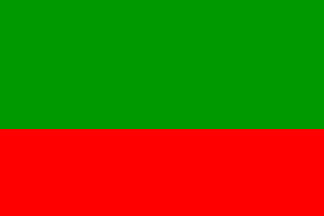
image by Ivan Sache, 18 January 2009
"Institución Educativa Distritál 'Miguel de Cervantes
Saavedra'" was set up on 27 August 2002 by the Federal
District of Bogotá (Decree No. 2524), succeeding "Centro
Educativo Distritál de Educación Básica y Media 'Miguel de
Cervantes Saavedra', which had been founded on 11 August 1997
(Decree No. 5581) by the merging of "Colegio La
Marichuela" and "Colegio 'Miguel de Cervantes de
Saavedra'"
The flag of the institute, as shown graphically and described on
the website
of the institute, is horizontally divided green-red (2:1).
Green represents vitality, youth, hope, respect and dedication.
Red represents fluor, humor, victory and liberty.
Ivan Sache, 18 January 2009
"Colegio Mochuelo Bajo" is located in the village of
Mochuelo Bajo, part of the Federal District of Bogotá.
The flag of the institute is described on the website
of the institute only by its colours, yellow, green and
white. The arrangement of the colours is not given.
Yellow represents people, the human touch and the cultural
diversity of the population.
Green represents the natural resources provided by the mountains,
arable lands and trees characteristic of the rural area of Ciudad
Bolívar.
White represents sociability and harmony, the social commitment
of the institute, and light and hope offerred to the population.
Ivan Sache, 17 January 2009

image by Ivan Sache, 4 January 2009
"Colegio Montemorel" was founded on 1 October 1994
in Bogotá; classes started on 7 February 1995. In 1997, the
institute was transfered to its rural seat in the municipality of
Chía; it was recognized next year by the Department of
Cundinamarca (Decree No. 1655).
The name of the institute was formed on "monte",
"mounts", as a tribute to the Colombian mountains, and
"mora", "blackberry", a plant with a great
capacity of adaptation and production.
The flag of the institute, as shown graphically on the website
of the institute, is divided green- turquoise blue by a
SSW-NNE diagonal and charged in the middle with the emblem of the
institute placed on a white disk
The colours represent ther harmony between heavens and the
natural environment, recalling the ecologic name of the college.
White represents purity and truth.
The emblem of the institute is made of a letter "M",
half blue, half green, on which walks a white silhouette. The two
parts of the "M" represent the touter and inner part of
knowledge, respectively. The outer knowledge develops the
rational skills of the left hemisphere of the brain, while the
inner knowledge relies on psychophysic strategies of human
development, involving the right part of the brain. In the middle
of the emblem is placed the essence of the process, a student
walking to self-knowledge.
Ivan Sache, 4 January 2009
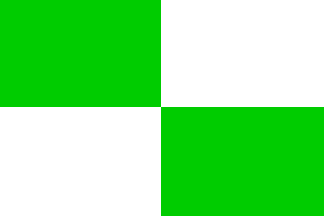
image by Ivan Sache, 8 January 2004
The Liceo was funded in Cordoba in 1953. Its flag is quartered
green-white.
Source: <www.voluntad.com.co>,
located by Dov Gutterman.
Ivan Sache, 8 January 2004